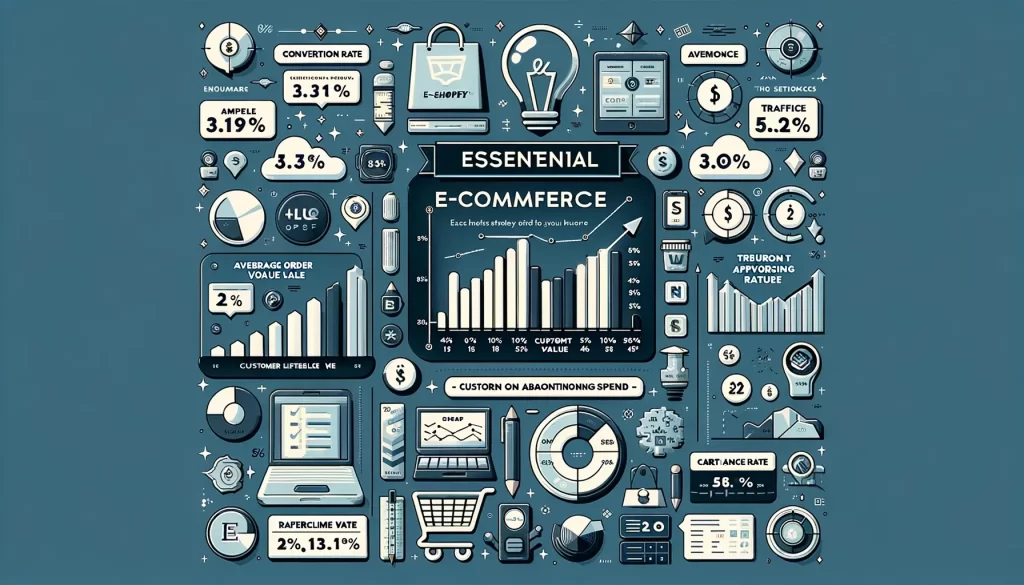As a Shopify store owner, having clear visibility into how your store is performing is critical. With key e-commerce metrics, you can track the health and growth of your business and make data-backed decisions to maximize sales and revenue. In this comprehensive blog, we will explore the most essential Shopify metrics you need to measure grouped across 4 key areas:
- – Traffic
- – Customer Acquisition
- – Sales
- – Marketing ROI
- – Product Performance Metrics
For each metric, we’ll share ideas and tips on analyzing and acting based on that data through real-world examples and scenarios. Let’s start unlocking the power of e-commerce analytics for your Shopify store’s success!
Traffic Metrics
Website traffic is the driving force of any e-commerce business. Without traffic coming into your online shop, no income will be made. Monitor classes, jump quotes, and pages consistent with a session to enhance consumer enjoyment. Track new vs returning customers and traffic assets for effective advertising strategies and expanded retention
Here are the key traffic metrics to track continuously:
Sessions and Users
Sessions check with the wide variety of browsing periods in your store. Users are the remember of precise visitors. This suggests the raw visitor’s extent your store is getting. Benchmark and aim to develop these consistently week-over-week through advertising marketing and SEO efforts.
Bounce Rate
Bounce price measures single-page periods where the consumer leaves your store without surfing similarly. High bounce prices, like 60%+, imply website UI/UX problems that cost you clients. Fix touchdown pages that no longer carry your value. Improve page load speeds. Enhance navigation for easier browsing to lower bounce rates.
Pages Per Session
This common depend of pages viewed for the duration of a surfing session gauges personal engagement. Low numbers below 2-3 reveal bad content material first-rate, puzzling save layouts leading users away. Ramp up vacationer engagement by improving product descriptions, using hanging snapshots, and including associated merchandise/recommendations as they browse specific pages.
New vs Returning Users
The percentage of new visitors vs those returning shows whether your store is sticky enough to retain customers. Rotate inventories, run loyalty programs, and offer incentives to bring back more visitors.
Traffic Sources
Whether it’s paid commercials, organic search, referrals, or social media, knowing where the highest site visitors source publications your marketing priorities and spending for sustaining growth. Double down on what works—whether this is polishing the search engine marketing recreation or allocating extra ad budgets closer to Facebook/Google campaigns yielding more visits. Kill what doesn’t!

Customer Acquisition Metrics
Now that site visitors have landed on our store, the following step is converting them into paying customers through the shopping journey. Optimize cart additions via A/B exams, enhance Average Order Value with upsells, and improve conversion prices. Engage deserted carts, providing seamless shopping studies for clients.
Let’s explore key metrics covering this conversion process:
Cart Additions
What % of store sessions lead to products being added to carts shows engagement. Use A/B tests to optimize ‘Add to Cart’ button placements/sizes, discounts, etc to lift conversions.
Average Order Value (AOV)
AOV measures the dollar value of each order on average. To grow AOV, recommend higher-priced products, bundles, warranties, etc., and offer volume discounts. Upsells are powerful!
Conversion Rate
The E-commerce conversion rate tracks the percentage of store sessions that led to orders. Anything above 2-3% is decent, and 4-5% is great! If lower, re-engage abandoned carts via emails/SMS and remove payment roadblocks.
Sales Metrics
Now that the clients have been acquired, it’s time to tune metrics across the order success technique and submit income as nicely. Track general sales, growth prices, and common success times to ensure a healthy income funnel. Prioritize client pride with Net Promoter Scores and manipulate return/exchange prices for best revenue retention.
Total Revenue
Overall revenue earned is the most crucial e-commerce metric reflecting the health of the sales funnel from top to bottom. Set revenue goals yearly and quarterly and optimize all the above metrics to hit them consistently.
Growth Rate
Month-over-month (MoM) or Year-over-Year (YoY) growth rates demonstrate rising or declining sales. Leverage growth as proof for getting investor funding for scaling business.
Average Fulfillment Time
The time between placing an order and delivery measures supply chain efficiency. Faster shipping improves customer experience. Assess any inventory/warehouse delays causing slowness.
Net Promoter Score (NPS)
NPS surveys measure customer satisfaction post-purchase based on the likelihood of recommended scores. They are a good metric for judging the effectiveness of products and services.
Return/Exchange Rates
Returns and exchanges eat into revenues if they occur too often. They signal subpar product quality or misunderstood buyer expectations. Tweak product descriptions accordingly or swap declining products.
Marketing ROI E-Commerce metrics
Marketing drives a significant chunk of e-commerce traffic and sales. Measuring the performance and impact of these initiatives is key. Evaluate cost per lead/acquisition, marketing contribution, and email/SMS campaign metrics. Optimize marketing channels, allocate budgets effectively, and enhance campaigns for maximum revenue impact.
Cost Per Lead/Acquisition
Assessing the advertising expenses per lead or customer is crucial for budget optimization on Google and Facebook. This analytical method is key to validating costs and discontinuing campaigns that don’t meet expectations. Including the requirement to hire Shopify developers is vital for a smooth online store, ultimately improving the success of the entire campaign.
Marketing Contribution
% of total revenue produced directly through marketing channels shows attribution. Double down on highly contributory channels with bigger budgets.
In addition to refining your marketing strategies, you must streamline your logistics for efficient order fulfillment. CEVA tracking services can help monitor shipments and optimize delivery processes, ensuring a seamless customer experience.
Email/SMS Campaign Metrics
Open, click, and conversion rates on marketing emails and SMS campaigns reveal list quality and message effectiveness. Useful for list segmentation and optimizing call-to-action.

Product Performance Metrics
Product fulfillment signs cover a spectrum of metrics aiding organizations in assessing the effectiveness of their merchandise. These metrics unveil insights into product performance, purchaser actions, and the general fitness of the enterprise. The following are typically examined metrics in this realm
Conversion Rate
The conversion rate is the share of website site visitors who make a purchase. An excessive conversion price signifies effective product pages and checkout approaches, contributing without delay to sales. Regularly optimizing those elements can enhance the general achievement of individual products and increase the overall monetary performance of the enterprise.
Average Order Value (AOV)
AOV represents the average amount customers spend in a single transaction. Increasing AOV is a strategic technique for maximizing sales without acquiring additional customers. Employing methods such as pass-promoting and upselling can encourage customers to add extra gadgets to their carts, definitely impacting the enterprise’s economic fitness.
Inventory Turnover
Inventory turnover measures how fast products are sold and changed. High turnover costs suggest efficient stock management, stopping overstocking and selling coins waft. Regular analysis of stock turnover permits businesses to optimize stock levels, ensuring healthy stability among supply and call.
Customer Lifetime Value (CLV)
CLV represents the entire revenue anticipated from a consumer over their dating with the business. Focusing on acquiring clients with higher CLVs guarantees sustained profitability. Building patron loyalty through amazing service and personalized experiences contributes to longer and more lucrative customer courting.
Return Rate
The return rate gauges the percentage of products customers return, offering insights into product quality and customer satisfaction. Monitoring and addressing return rate trends are crucial for maintaining a positive brand reputation and minimizing the impact of returns on overall product performance and profitability.
Average Order Value (AOV)
The Average Order Value (AOV) represents the average value spent by a customer in a single transaction. Combining AOV with purchase frequency provides insights into the customer’s spending habits.
Customer Retention Rate
CLV considers the likelihood of a customer remaining loyal over time. Monitoring the customer retention rate helps estimate the duration of the customer’s relationship with the business.
Customer Acquisition Cost (CAC)
To determine a customer’s profitability, the cost of acquiring that customer must be considered. The ratio of CLV to CAC is often used to assess the overall return on investment.
Churn Rate
The churn charge represents the percentage of customers who discontinue their relationship with the commercial enterprise over a particular duration. A decrease in churn price contributes positively to CLV by extending the customer’s lifespan.
Final Thought
A Shopify store’s maturity may be determined by tracking e-commerce indicators. This will give you important insights into important business areas. To improve long-term outcomes, use the practical advice provided for each metric. Customize these insights using market-specific variables that pertain to your range of products. Make data-driven decisions by utilizing the power of e-commerce intelligence to increase client lifetime value and store revenues. Utilize analytics programs like Google Analytics to provide a unified data source and streamline data collection. Recognize accomplishments and provide information internally. Use these KPIs as a constant reference point when making business decisions in doubt. Consider setting up an ODC to maximize operational effectiveness and resource usage further.

